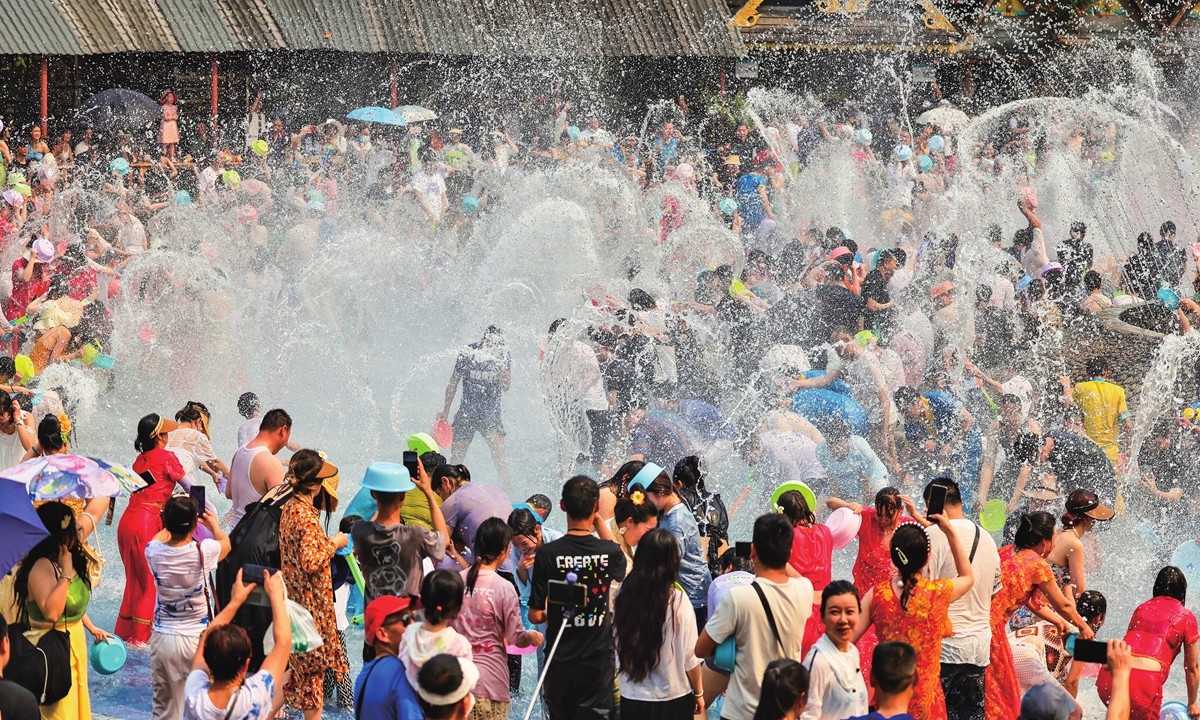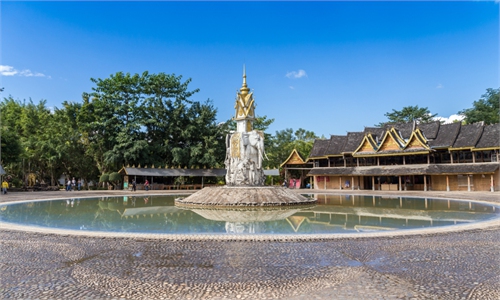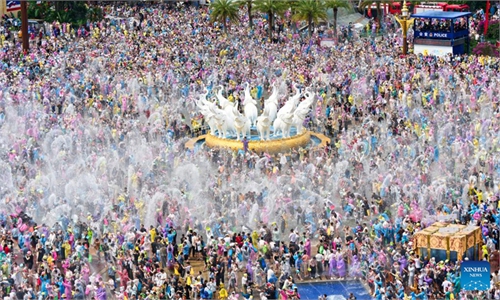ARTS / CULTURE & LEISURE
Water-splashing festival fuels Yunnan tourism
An ocean of joy

Tourists and residents celebrate the water-splashing festival in Xishuangbanna Dai Autonomous Prefecture, Southwest China's Yunnan Province. Photo: VCG
Under a canopy of brilliant spring sunshine, cities across Southwest China's Yunnan Province have erupted into a kaleidoscope of color, laughter, and flying water as the annual water-splashing festival swept through many cities in Yunnan this week.From vibrant streets of Ruili to historic alleys of Jinghong and the bustling squares of Kunming, crowds gather in joyful celebration, dousing one another with buckets, basins, and water guns. The air is alive with the sound of drums, traditional music, and the delighted shrieks of locals and international tourists who come together to welcome the New Year of the Dai ethnic group sharing blessings of purity, renewal, and unity.
The water-splashing festival is regarded as one of the most important festivals of ethnic groups in Southwest China. During the festival, water is considered an auspicious symbol and people splash water on one another, thereby wishing each other happiness and good fortune.
Yao Zhi, a resident in Jinghong city of Xishuangbanna Dai Autonomous Prefecture, told the Global Times on Wednesday that water-splashing festival is the most important festival in Xishuangbanna and is a sacred yearly ritual to the Dai people.
It also serves as a window for Xishuangbanna to showcase itself to the world each year, and it's an important day for cultural exchange among different ethnic groups, said Yao who took part in the dragon boat races, flying Kongming lanterns, a kind of small hot-air paper balloon, and joined the float parade during the festival.
Fostering unity
The water festival was also celebrated in many countries in Southeast Asia. It is known as the Khmer New Year in Cambodia, while it is called the Songkran Festival in Thailand.
On April 13, youngsters from Laos, Cambodia, Vietnam, and Thailand gathered in Jinghong to celebrate the festival together with Chinese counterparts by releasing Kongming lanterns over the Lancang River as part of a cultural exchange program, Yunnan Daily reported.
Xiong Kunxin, a professor at the Minzu University of China in Beijing, told the Global Times that the core value of the water splashing festival lies in its power to bring people together as it fosters unity, togetherness, celebration, joy, and a spirit of sharing among all ethnic groups. During the festivities, distinctions of ethnicity, gender, or age dissolve, as everyone joins in the revelry on equal and joyful terms.
The festival has gradually become a beloved celebration shared and enjoyed by various ethnic groups across Southeast Asia. It serves as a platform for grassroots cultural exchange, promoting mutual learning and understanding. As such, it is also an effective means of building a community with a shared future among the diverse peoples of Southeast Asia, Xiong noted.
Having attended the festival in Xishuangbanna a few years ago, Xiong felt completely immersed in the celebration while using basins, water guns, or buckets to splash water on one another, saying that it was like being immersed in an ocean of joy.
"I believe such folk cultural exchange activities should be passed down year after year and promoted across generations," he remarked.
While preserving traditions, the local authorities have been committed to combining the festival with modern elements to attract more young people to Yunnan, injecting new vitality into the development of the province's cultural and tourism industries.
Embracing innovation
Luo Kelinqi, director of the bureau of culture and tourism in Menghai county of Xishuangbanna, told the Global Times that the county is adopting a model of "intangible cultural heritage plus creative market" to integrate traditional craftsmanship with modern design. They have also launched themed tourism routes to build a distinctive cultural and tourism brand around the water festival.
"The tourism routes cover tea culture experiences, cycling, hiking, and wellness activities in tea plantations to meet diverse needs. We hope to extend the popularity of the water festival into the May Day holidays, making Menghai a year-round cultural and tourism destination," Luo said.
"By providing stipends for inheritors of intangible cultural heritage and establishing heritage transmission bases, traditional ethnic culture is being effectively preserved and passed on, becoming a key driver of local cultural and tourism development," Luo noted.
The Gengma Dai and Va Autonomous county of Lincang in Yunnan, which has made a splash on China's social media for creating a sensational music series for the water festival since 2018, infused symphonic music and Dai ethnic dance in its 2025 edition in collaboration with the Concerto Budapest Symphony Orchestra.
The video series is part of the local efforts in exploring the inheritance and innovative dissemination of ethnic culture, promoting the integrated development of the local cultural and tourism industries.
Thanks to the China-Laos Railway and the visa-free transit policy, Yunnan is becoming increasingly popular in the international cultural and tourism market. During this year's water festival, the number of tourists from Laos, Myanmar, Thailand, and other neighboring countries has surged with nearly 400 international tourists visiting Jinghong on April 12, when the Dai New Year gala show was held, Yunnan.cn reported.
By continuously innovating and enriching the festival's cultural significance, it can contribute to shared economic and cultural prosperity as well as high-quality development among different ethnic groups, thereby supporting the building of a community with a shared future for mankind, explained professor Xiong.


